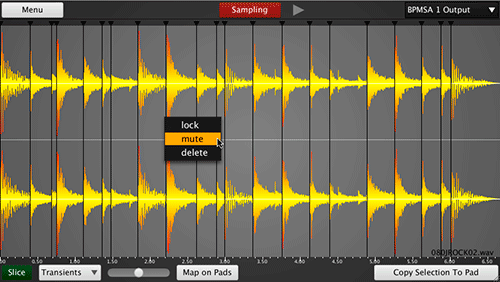- Buy Now
- |
- Upgrade
- |
- Downloads
- |
- News
- |
- Tech Notes
BPM — Advanced urban rhythm instrument
Features
- Overview
- New in 1.5
- Videos and MP3s
- FlexLoops™
- Loops and instruments
- 19 GB sound library
- Beat Box Anthology
- Hardware controllers
- Advanced programming
- Apply grooves
- Record and sample
- Mix and process (FX)
- Perform live
- Build a song
- Import and export
- Feature highlights
- Sound library highlights
- Specifications
- More sounds

"BPM is a remarkable instrument, providing almost everything you could ever want in a beat-production machine."
Read more »

"It sounds, looks and feels great and is one of the best urban music production tools currently available."
Read more »
Loops and instruments
In addition to its banks (for kits and patterns), BPM provides two racks which can hold an unlimited number of instrument parts and loops.
A part can hold a loop, an audio phrase (triggered by MIDI or the piano roll sequencer) or a multi-sample instrument (bass, guitar, keys, etc.), also triggered by its own piano roll sequence.
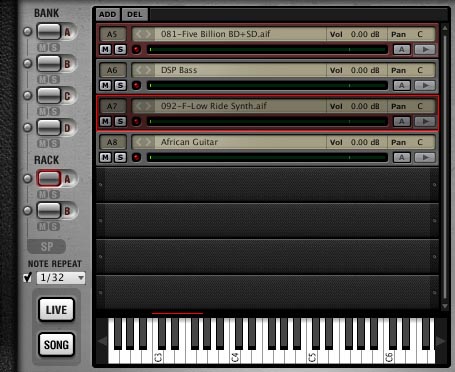
BPM gives you two racks (A and B) so you can organize your parts into two separate groups (loops versus instruments, perhaps) and then apply mute/solo, FX processing, etc. to the two racks independently. But you can use the two racks however you want, as BPM is totally flexible in their operation.
The keyboard at the bottom of the part list lets you play the currently selected part. You can even record your performance into BPM.
Drag and drop to import loops
Like just about everywhere else in BPM, you can use drag and drop techniques in the Rack part lists, too. Just drag and drop any loop or audio file from BPM's browser or your computer desktop into the part list to add it to your mix.
Sequence instruments and slice loops in the Piano Roll Editor
When you click a part, the Piano Roll Editor appears. This is where you program a MIDI note sequence that triggers the instrument or, if the part is loaded with a loop, the individual slices of a sliced loop. The Piano Roll Editor is like having a built-in sequencer with all the tools you need for fast and effective beat programming, right at your fingertips.
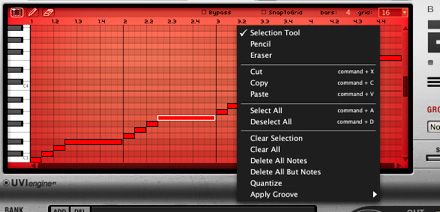
Edit part parameters quickly
The Part Editor for the currently selected part gives you detailed programming for the instrument or loop.

Control your loops
Loops have the following additional parameters in the Loop tab. As you can see, there are detailed controls for how the loop will start, how fast it will play, and how it will sync to the rest of BPM (or your host software). You can also drag and drop loops to export them as WAV files into your host software or to your computer desktop. Beat-sliced loops can also be exported as a standard MIDI file clip.
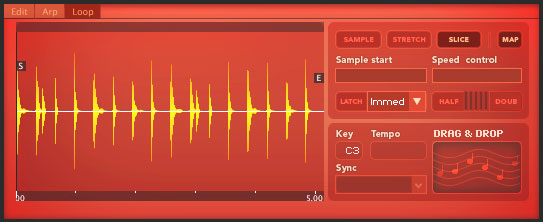
BPM provides three different loop modes so you can treat loops as traditional samples, non-slice-loops or slice-loops. In Slice mode, BPM gives you access to the individual slices in a slice-loop so you can play them separately. This allows you to completely rebuild the loop from scratch using its individual slices.
Beat slice editing
NEW IN VERSION 1.0.5 — if you drag a slice loop (or record new rhythmic material) into BPM's clip window, you can add, move, lock, mute, and delete beat slices. This gives you complete control over each individual slice and how they are mapped to the pads in BPM.
Arpeggiate bass lines, chords or other instrument parts
NEW IN VERSION 1.0.5 — each instrument part has its own arpeggiator, with advanced controls and dozens of arpeggiator presets. Or create and save your own presets.
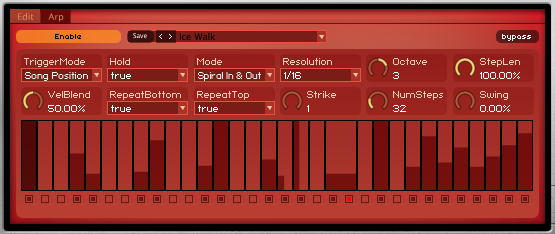
Numerous settings give you complete control over the number of steps, step length, resolution, trigger mode, groove (swing) and more.







